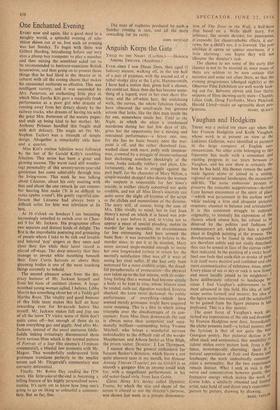Vaughan and Hodgkins
THERE was a period ten years ago when the late Frances Hodgkins and Keith Vaughan, whose work is at present on view at the .Leicester Galleries, were identified as partners in the large company of English neo- romanticism. No other artist belonging to this fraternity has made such a consistent and exciting progress in tae years between as Vaughan. and his new show is certainly the best he has held. His themes remain the same, male figures alone or joined in a settins• regional or seasonal landscapes, the occasional still-life. The same endeavour persists lo preserve the romantic suggestiveness—derived from human encounters or the spirit of plats —which was paramount in his earliest work while making a firm and eloquent pictorial structure, classical in balance and articulation. It is this consistent struggle to cultivate originality, to intensify his expression of the themes which obsess him, his refusal to he, deterred by the politics and fashions 01 contemporary art, which give him a special place in English painting at the present. The developments to be found in this exhibition are therefore subtle and not easily described; they can be sensed in face of the canvas rather than indicated. In the painting of a rocky head- land one feels that each• slab or stroke of paint is in itself more decisive and confident and also more communicative of substance, mass, space; Every plane of sea or sky or rock is now limner and more lucidly .joined to its neighbour. I have deliberately referred to landscape be- cause I find Vaughan's achievement tcsbt most advanced in this field. His idea of land' scape seems formed and mature; his idea of the figure seems less secure, and-the satisfaction to be gained from his figure pictures is less profound. This is a tine painter. The quiet force of Vaughan's work dir turbed my impressions of the oils and drawings by Frances Hodgkins next door. Immediately the cliche presents itself—a lyrical painter, and the lyricism is that of not quite the he' Georgian poetry. Her pictorial diction is 5° often slack and sentimental. Her sensibility t0 colour makes every picture look, from a dis- tance, monotonously charming: there is natural appreciation of fruit and flowers and landscape; the work undoubtedly communi- cates a personality. But the two experiences remain distinct. What I seek in vain is that nerve and concentration however gentle. that formative energy which makes the work 0', Gwen John, a similarly obsessed and limited artist, take hold of and direct one's experience' picture by picture, drawing by drawing.


































 Previous page
Previous page